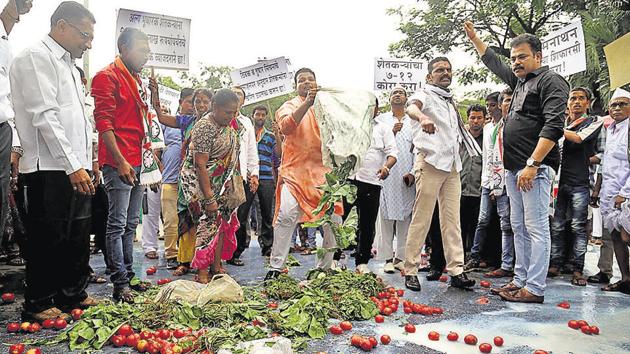That sinking feeling that comes from food deflation
Food deflation is occurring against the backdrop of bumper crop production after two back-to-back drought years. The State usually intervenes by providing minimum support prices for wheat, rice and several other major crops. However, in recent years, these minimum support prices have failed to keep pace with rising input costs of crop cultivation – making farming an increasingly unviable proposition.
Agrarian distress casts a troubling shadow over the India growth story, a current facet of which is food deflation or an across-the board crash in food, fruit and vegetable prices. This is sparking unrest even in vanguard agricultural regions such as western Maharashtra and Madhya Pradesh. Earlier this month, farmers went on the rampage in Mandsaur in MP demanding better prices for their produce and waiver of loans. Agriculturists in Rajasthan, too, have demanded higher prices. In April, farmers in Andhra Pradesh and Telengana protested against the free-falling red chilli prices, which were a quarter of those prevailing last year.

Food deflation is occurring against the backdrop of bumper crop production after two back-to-back drought years. Economists typically attribute the falling food prices to demand-supply mismatches. When farmers reap record harvests, prices are bound to collapse with excess production. The opposite holds if there are severe shortages and prices spiral upwards. But the State heavily intervenes in Indian agriculture by providing minimum support prices for wheat, rice and several other major crops. However, in recent years, these minimum support prices have failed to keep pace with rising input costs of crop cultivation – making farming an increasingly unviable proposition.
The knee-jerk response of state governments to the ongoing farmer unrest due to food deflation is loan waivers. But if a loan waiver was a magic bullet to solve the crisis of farming, then the massive loan waiver if Rs 72,000 crore in 2008 would have surely done the trick. But it hasn’t. The waivers announced by Maharashtra and Uttar Pradesh would only impair their finances to provide infrastructural support to agriculture. Stepping up public investment in irrigation is imperative. More remunerative prices are necessary to neutralise soaring costs of cultivation. Farmers need to be better linked to urban markets.
Back to food deflation, it would be unwise to dismiss it as only a demand-supply problem. What is interesting in this regard is the timing of the generalised price crash as it occurred when the country was experiencing the rigours of demonetisation from November 8, 2016 onwards when high denomination notes were taken off circulation. The shock to the cash economy was felt most acutely in Indian agriculture. Cash is needed for seeds and fertilisers. Farmers have no access to formal funding while informal money lending dried up. They need to be paid for the crops that have been harvested.
So when bumper crops came to markets, liquidity had dried up. Across-the-board, prices crashed of every crop marketed since November like soya bean, green gram, pigeon-pea, potatoes, tomato, onions, garlic, grapes, red chillies, among others. Garlic and methi or fenugreek prices crashed in Mandsaur, which averaged Rs 3,400 and Rs 3,100-3,200 per quintal in April as against Rs 4,400-4, 800 respectively at the same time last year. According to him, the food deflation is linked to demonetisation as the cash shortages hit produce trading, resulting in farmers selling at rock-bottom prices.
The spectre of food deflation will not go away unless the neglect of crisis-ridden agrarian India is redressed. More than loan waivers, the sector needs to be put on a modern footing. Policy makers still have a mindset that only cereals constitute the bulk of output. Not any more as horticultural production has outstripped food production. Farmers are growing more and more commercial crops. There is a need for more cold chains that can store this produce. There is a need for crop insurance schemes that insure farmers against boom-bust cycles and remunerative price support. Farming needs to be made more viable.
N Chandra Mohan is an economics and business commentator based in New Delhi.
The views expressed are personal



